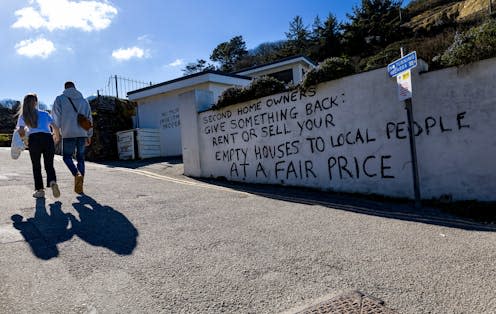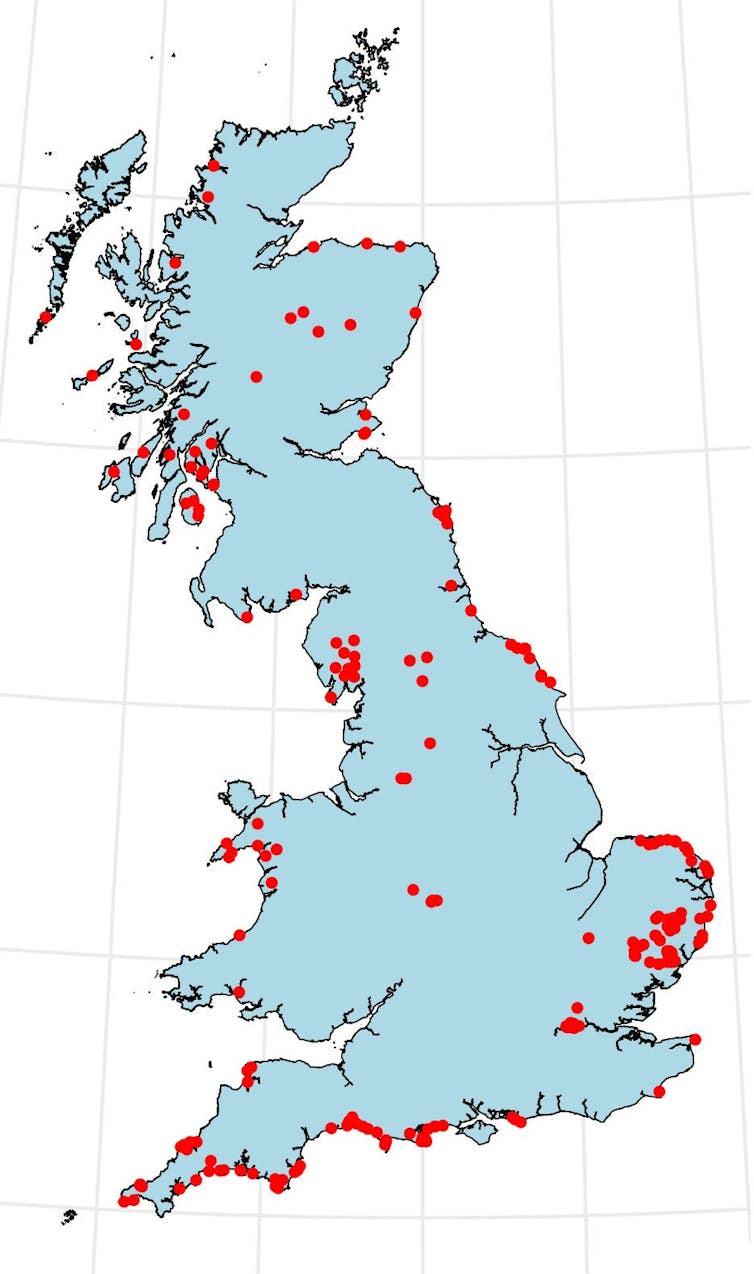The UK’s coastal ‘ghost enclaves’ are the result of government failure on low-use homes

The UK has long been in the middle of a housing crisis. And yet, across the country, the number of low-use homes is growing.
Housing experts like ourselves use the term “low-use” to refer both to unoccupied properties and to infrequently used second homes.
Data from the 2021 census revealed 1.5 million unoccupied dwellings in England (6.1% of all dwellings) and 120,450 in Wales (8.2%). In Scotland, that figure stands at 90,700 unoccupied dwellings (3%), according to the National Records of Scotland (there is no comparable data for Northern Ireland).
This overlaps with the rising popularity of the short-term let market, in which Airbnb leads the charge. The census also showed that in certain popular coastal areas of England and Wales, one in ten homes are second homes, often used as holiday lets to help make ownership sustainable or profitable.
Low-use properties take units that might be available as long-term homes out of circulation. This shows up as a loss of properties to rent or buy, which in turn causes rents and house prices to rise, squeezing local purchases and renters out of the market. The more low-use properties there are in any given area, the more the impact on local community life can be devastating.
One of us (Jonathan Bourne) has developed a way to map the extent and value of low-use domestic property in England and Wales. We have used this methodology to prepare a new report on low-use housing in collaboration with the UK charities, abrdn Financial Fairness Trust and Action on Empty Homes.
This research looks at the prevalence and impact of low-use housing for England, Wales and Scotland. Our map of what we’ve called “ghost enclaves” – the most concentrated areas of low-use properties – suggests that this is almost exclusively a coastal phenomenon. It effectively outlines the island of Great Britain in red.
The ‘ghost enclaves’ of Great Britain where at least 20% of properties are low-use:

Since 2022, we have gathered council tax data at what statisticians term “lower super output area” level. These are small areas containing between 400 and 1,200 housholds (or 1,000-3,000 people). Each approximates a community or neighbourhood unit. In England, there are just over 33,000 of these areas.
Of the 371 local authorities (or equivalent) across England, Scotland and Wales, we got data from 205 – covering 64% of the population of the three nations. We found that large numbers of local authorities have areas in which 5% or more homes are low-use. In 50 of the 205 council areas we looked at, we also found ghost enclaves where at least 20% of properties – and as many as half in some areas – are empty or largely unoccupied.
In the ghost enclaves that topped our ranking, low-use homes account for between 34% and 54% of the local housing stock. These areas include Trawsfynnydd and New Quay in Wales; St Ives, Padstow, Grasmere and Benthall in England; and Earlsferry and Millport in Scotland.
Because of the way that short lets often include whole “primary” homes where people rent their home out part of the time, and second homes which are rented out, our analysis is likely to underestimate the full extent of the problem. Because of the potential to make money using these avenues in areas of high demand for tourist accommodation, we often find homes being tipped out of the homeowner and private rental markets into the holiday-let market.
We also interviewed 66 experts and campaigners across the UK: housing and planning officials, policy experts, campaigners, residents, councillors and politicians at local and national levels, plus trade body representatives.
They described how second homes and short-term lets have hollowed out many communities. Demand for essential services like schools has reduced as a result. Year-round social infrastructure, such as pubs and cafes, has withered due to the outsized seasonal demand followed by long fallow periods. Communities feel significant resentment.
Our findings chime with census data showing that Londoners are increasingly buying investment properties in the national parks and coastal areas of the south-west. Similarly, affluent households in the north-west of England are buying second homes in north Wales.
One planner we interviewed said any benefits from increasing housing development in rural areas (a policy that many support) – including releasing more land for housing and allowing rural exception sites, barn conversions and developments on small “pocket” sites (such as in a garden or between houses) – are essentially cancelled out by people turning existing stock into Airbnbs, holiday lets and second homes. “And we have no planning control over that,” one planner explained. They likened the whole exercise to filling the bath with the plug pulled out.
Why the planning system needs to change
Our research shows how many areas have become sinks for investment cash. This money has often been generated by the rising wealth of homeowners privileged by the economic settings of recent decades – notably low interest rates, but also significant tax privileges for holiday lettings and landlords (though this is beginning to change).
Small towns and villages have thus become places of both abundant investment wealth and social poverty. For local residents, house prices are too high and rental options are often non-existent. Over time, these communities are being pushed out.
Simply building more homes will not solve this problem. But there are ways for lenders and governments to rebalance the housing options and local economies in rural and coastal areas.
First, lenders can team up with local authorities to share the live council tax data that shows those areas (just as we did) of concentrated low-use (above 5% of homes). This would help them to block further lending for investors, and instead focus on those who need homes to live in. In an exciting move, Leeds Building Society has duly announced a trial ban on holiday-let mortgages for parts of North Yorkshire and north Norfolk.
Second, raising stamp duty rates on second dwellings in areas where there are more than 5% low-use properties would also slow investment purchasing, by raising the effective cost of second homes. Such a tax could help councils raise income that could be used to bring other empty homes into use, or to help other local affordable housing projects.
To make any viable solution work, though, the planning system needs to be altered. In all parts of the UK, a distinction needs to be made between primary residences, second homes and short-term lets.
In England, a planning classification for short-term lets has been introduced, but another is needed for second homes. This would help the planning system to be an effective tool in preventing excessive concentrations of low-use properties. Introducing an effective licensing scheme (now in full operation in Barcelona and Amsterdam) for short-term lets would also help block what we might call the “airbnbification” of entire districts.
Without urgent action, low-use properties and the UK’s ghost enclaves will remain symbols of a broken housing system that places vulnerable and low-income households at the mercy of an investor economy of quick gains and good holidays. Asset owners will continue to expand their portfolios – and pensions – while poorer households struggle even to find a home.
This article is republished from The Conversation under a Creative Commons license. Read the original article.

Rowland Atkinson received funding from abrdn Financial Fairness Trust to conduct this research.
Jonathan Bourne received funding from abrdn Financial Fairness Trust to conduct this research.
Rafaella Simas Lima received funding from abrdn Financial Fairness Trust.

 Yahoo News
Yahoo News 
